-
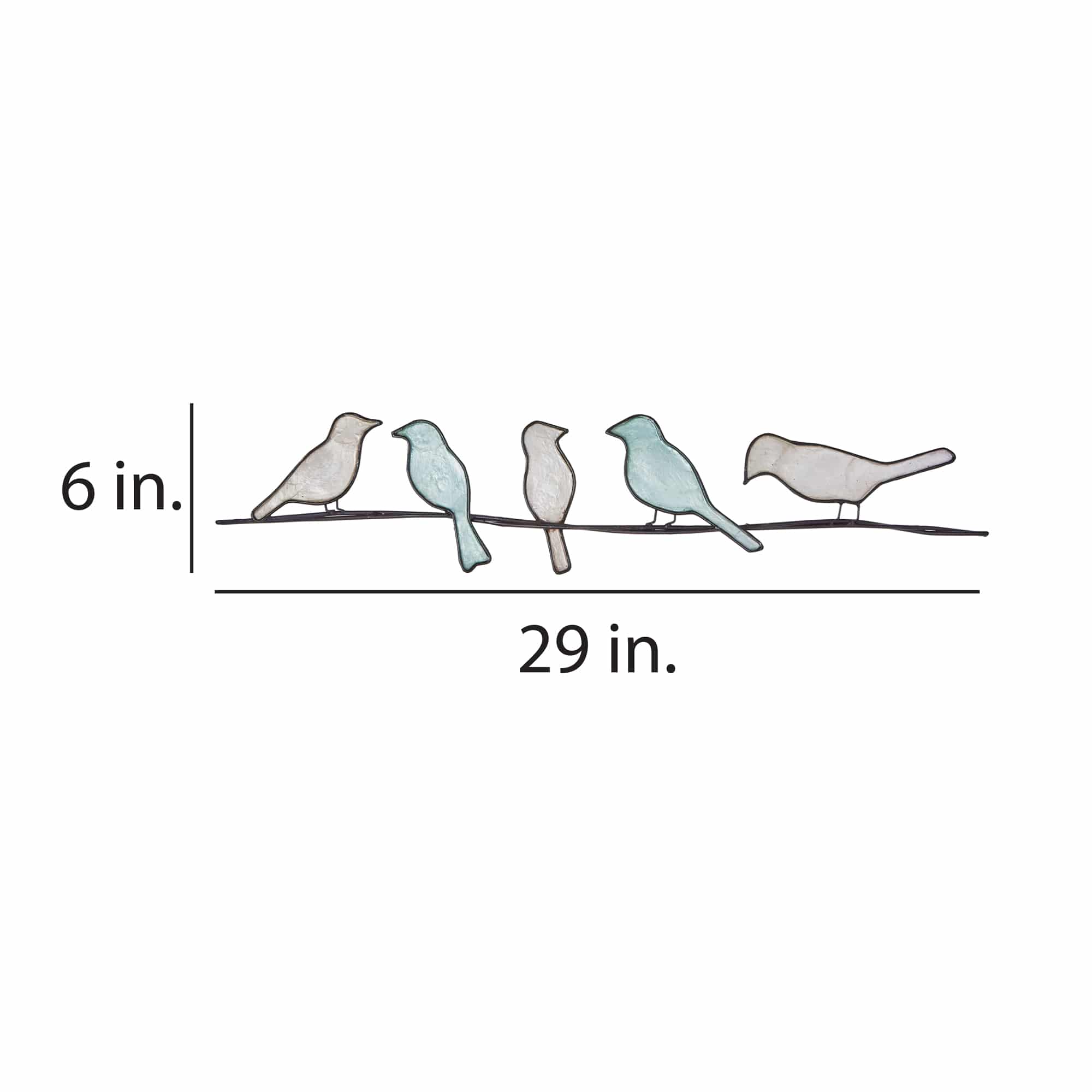
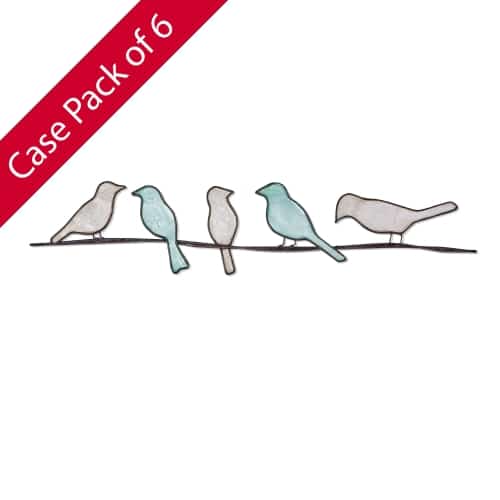 Case of 6 An old parable states that five birds were resting on a wire. Two decided to fly south. How many were birds are left? One's initial answer may be three, however, the answer is still five. The moral of the fable is actions are more important than intention; a kind reminder that a truer picture of one's character is drawn by actions. The artisan captures this parable by lining up five birds socializing on a wire. The basic frame of this piece is created using tin, which is powder coated with a black finish. The frame is reinforced using tin wire along the inner edge. The front of the body is adorned with capiz. Capiz is an oyster shell and the primary purpose of the oyster is as a source of food. However, the by-product, the shell, can be used for decoration. Due to it being a natural material, the natural colors of the capiz may come through as tans and browns underneath the hand-painted surface.
Case of 6 An old parable states that five birds were resting on a wire. Two decided to fly south. How many were birds are left? One's initial answer may be three, however, the answer is still five. The moral of the fable is actions are more important than intention; a kind reminder that a truer picture of one's character is drawn by actions. The artisan captures this parable by lining up five birds socializing on a wire. The basic frame of this piece is created using tin, which is powder coated with a black finish. The frame is reinforced using tin wire along the inner edge. The front of the body is adorned with capiz. Capiz is an oyster shell and the primary purpose of the oyster is as a source of food. However, the by-product, the shell, can be used for decoration. Due to it being a natural material, the natural colors of the capiz may come through as tans and browns underneath the hand-painted surface. -

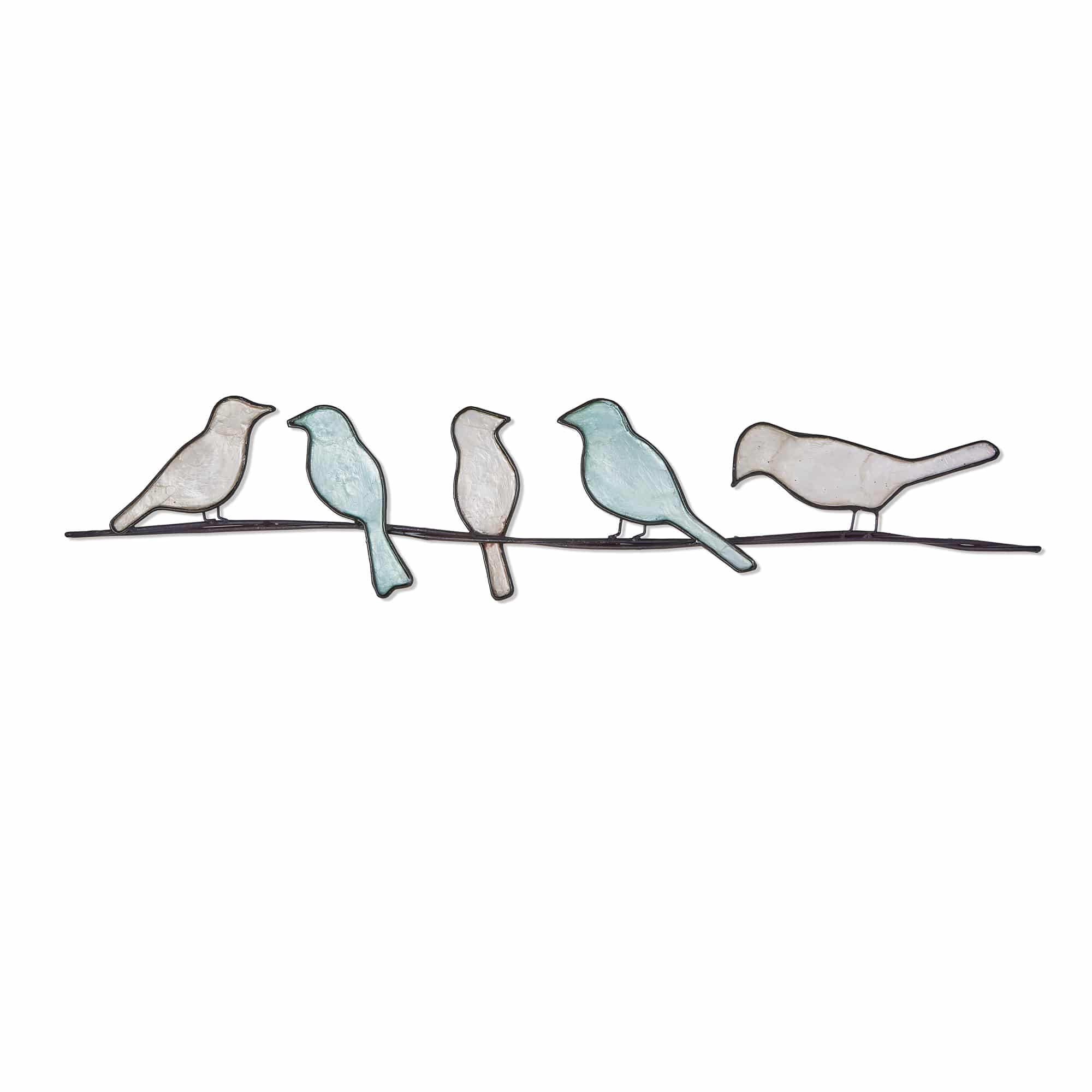 An old parable states that five birds were resting on a wire. Two decided to fly south. How many were birds are left? One's initial answer may be three, however, the answer is still five. The moral of the fable is actions are more important than intention; a kind reminder that a truer picture of one's character is drawn by actions. The artisan captures this parable by lining up five birds socializing on a wire. The basic frame of this piece is created using tin, which is powder coated with a black finish. The frame is reinforced using tin wire along the inner edge. The front of the body is adorned with capiz. Capiz is an oyster shell and the primary purpose of the oyster is as a source of food. However, the by-product, the shell, can be used for decoration. Due to it being a natural material, the natural colors of the capiz may come through as tans and browns underneath the hand-painted surface.
An old parable states that five birds were resting on a wire. Two decided to fly south. How many were birds are left? One's initial answer may be three, however, the answer is still five. The moral of the fable is actions are more important than intention; a kind reminder that a truer picture of one's character is drawn by actions. The artisan captures this parable by lining up five birds socializing on a wire. The basic frame of this piece is created using tin, which is powder coated with a black finish. The frame is reinforced using tin wire along the inner edge. The front of the body is adorned with capiz. Capiz is an oyster shell and the primary purpose of the oyster is as a source of food. However, the by-product, the shell, can be used for decoration. Due to it being a natural material, the natural colors of the capiz may come through as tans and browns underneath the hand-painted surface. -
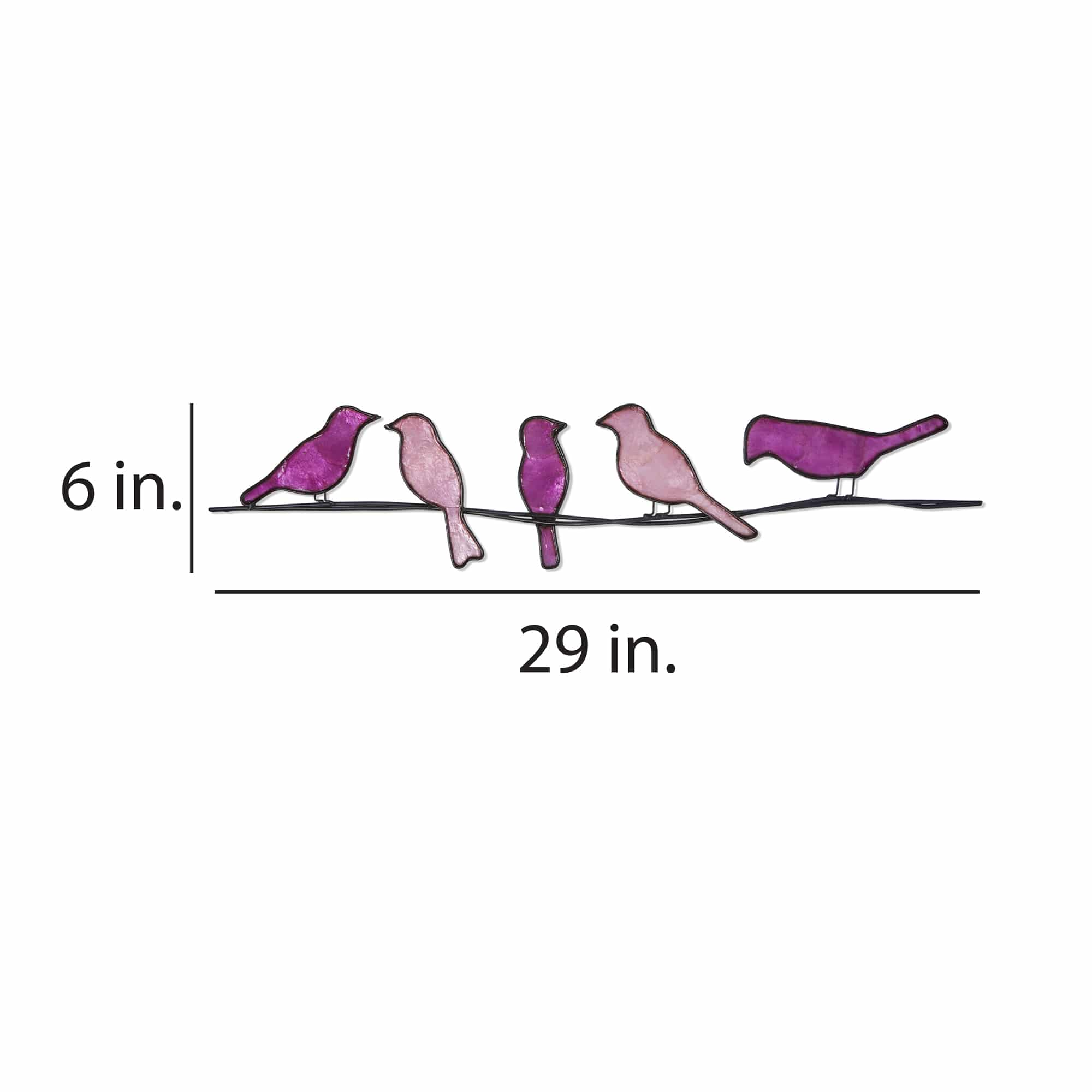
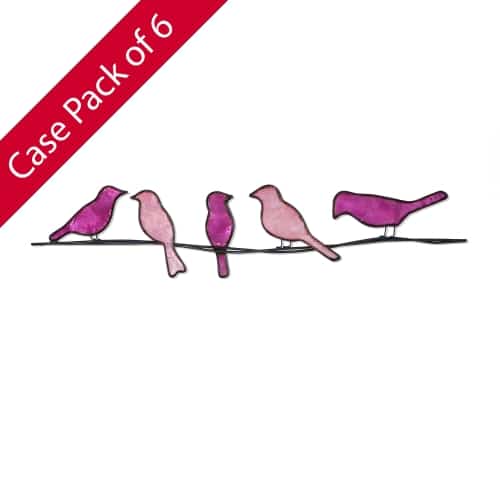 Case of 6 An old parable states that five birds were resting on a wire. Two decided to fly south. How many were birds are left? One's initial answer may be three, however, the answer is still five. The moral of the fable is actions are more important than intention; a kind reminder that a truer picture of one's character is drawn by actions. The artisan captures this parable by lining up five birds socializing on a wire. The basic frame of this piece is created using tin, which is powder coated with a black finish. The frame is reinforced using tin wire along the inner edge. The front of the body is adorned with capiz. Capiz is an oyster shell and the primary purpose of the oyster is as a source of food. However, the by-product, the shell, can be used for decoration. Due to it being a natural material, the natural colors of the capiz may come through as tans and browns underneath the hand-painted surface.
Case of 6 An old parable states that five birds were resting on a wire. Two decided to fly south. How many were birds are left? One's initial answer may be three, however, the answer is still five. The moral of the fable is actions are more important than intention; a kind reminder that a truer picture of one's character is drawn by actions. The artisan captures this parable by lining up five birds socializing on a wire. The basic frame of this piece is created using tin, which is powder coated with a black finish. The frame is reinforced using tin wire along the inner edge. The front of the body is adorned with capiz. Capiz is an oyster shell and the primary purpose of the oyster is as a source of food. However, the by-product, the shell, can be used for decoration. Due to it being a natural material, the natural colors of the capiz may come through as tans and browns underneath the hand-painted surface. -

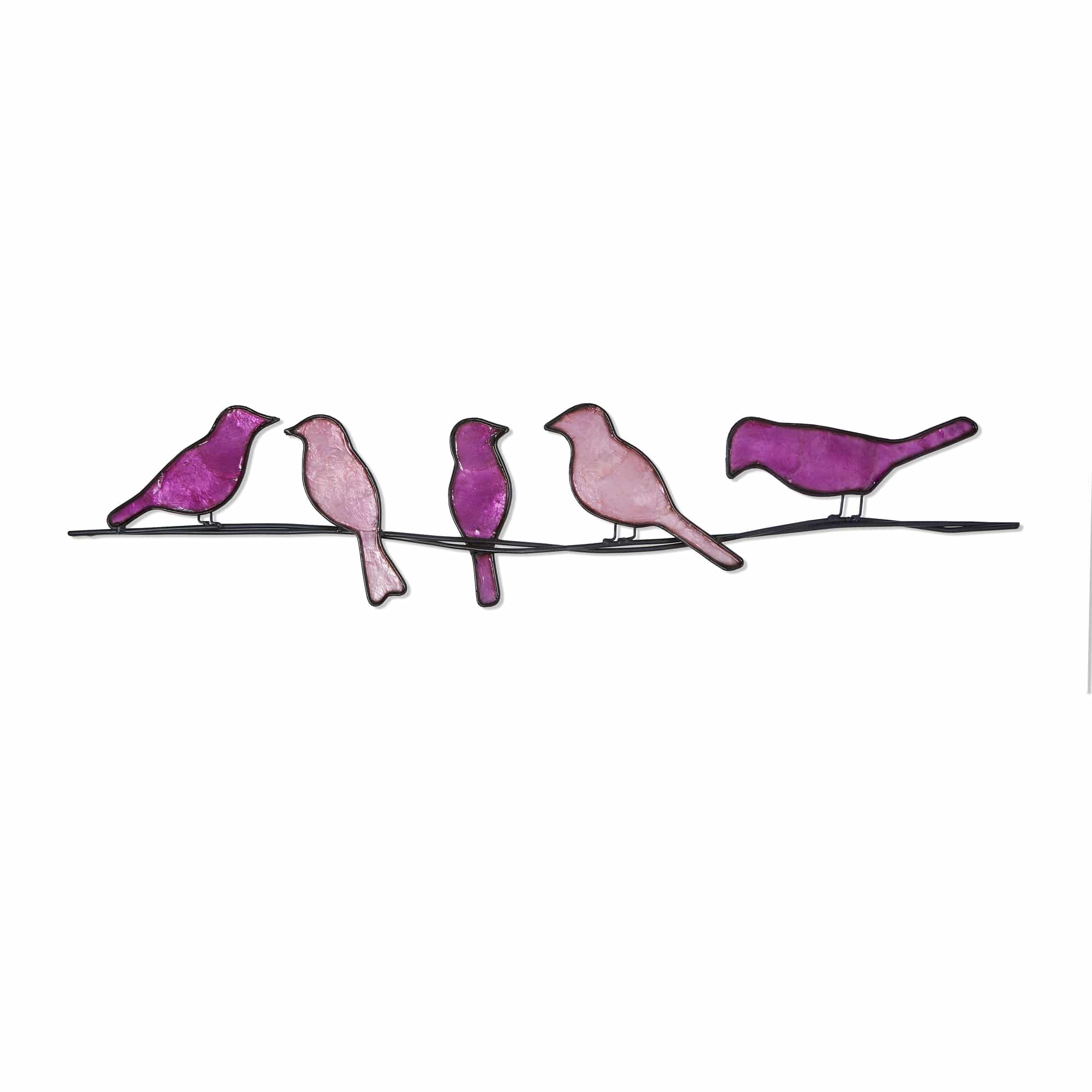 An old parable states that five birds were resting on a wire. Two decided to fly south. How many were birds are left? One's initial answer may be three, however, the answer is still five. The moral of the fable is actions are more important than intention; a kind reminder that a truer picture of one's character is drawn by actions. The artisan captures this parable by lining up five birds socializing on a wire. The basic frame of this piece is created using tin, which is powder coated with a black finish. The frame is reinforced using tin wire along the inner edge. The front of the body is adorned with capiz. Capiz is an oyster shell and the primary purpose of the oyster is as a source of food. However, the by-product, the shell, can be used for decoration. Due to it being a natural material, the natural colors of the capiz may come through as tans and browns underneath the hand-painted surface.
An old parable states that five birds were resting on a wire. Two decided to fly south. How many were birds are left? One's initial answer may be three, however, the answer is still five. The moral of the fable is actions are more important than intention; a kind reminder that a truer picture of one's character is drawn by actions. The artisan captures this parable by lining up five birds socializing on a wire. The basic frame of this piece is created using tin, which is powder coated with a black finish. The frame is reinforced using tin wire along the inner edge. The front of the body is adorned with capiz. Capiz is an oyster shell and the primary purpose of the oyster is as a source of food. However, the by-product, the shell, can be used for decoration. Due to it being a natural material, the natural colors of the capiz may come through as tans and browns underneath the hand-painted surface. -
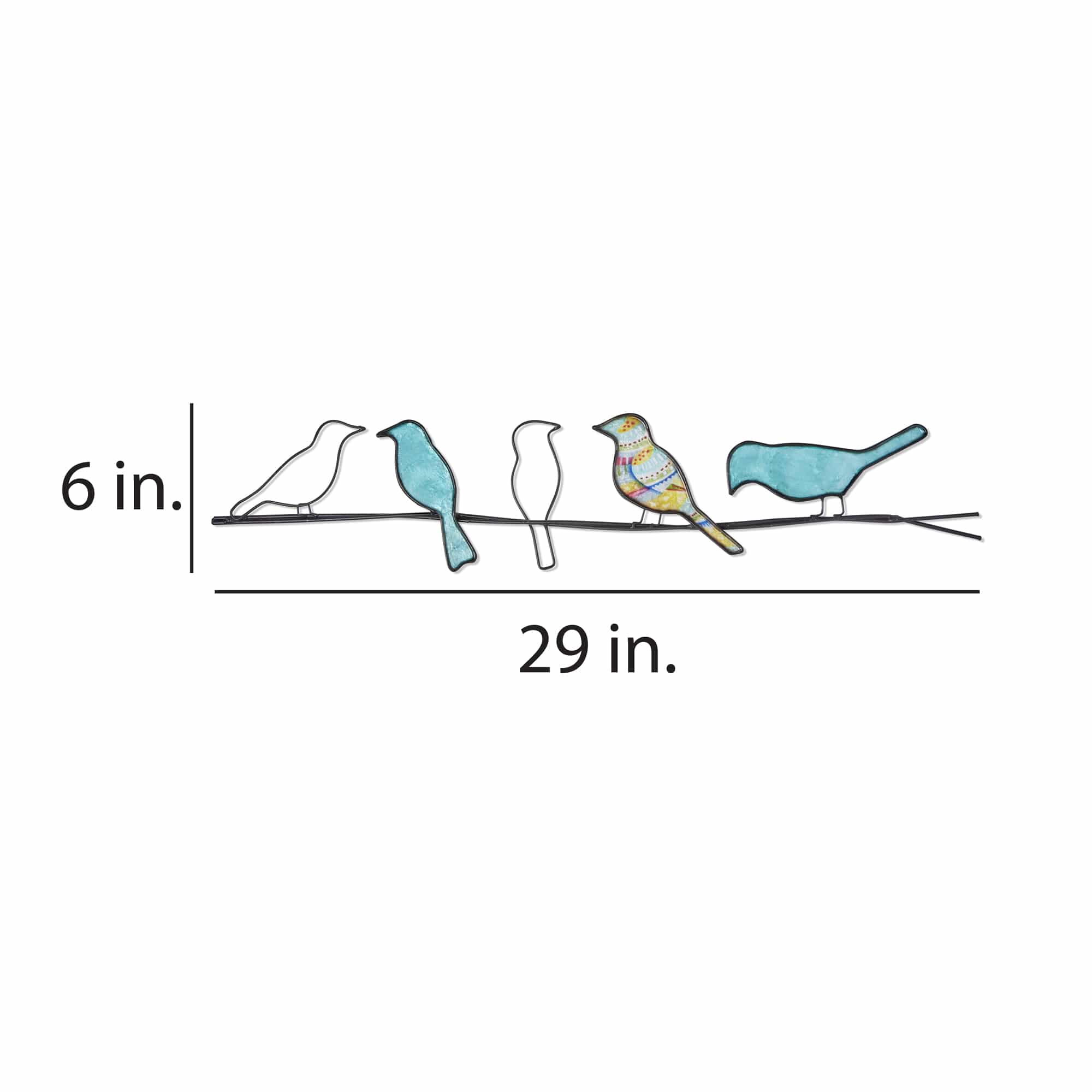
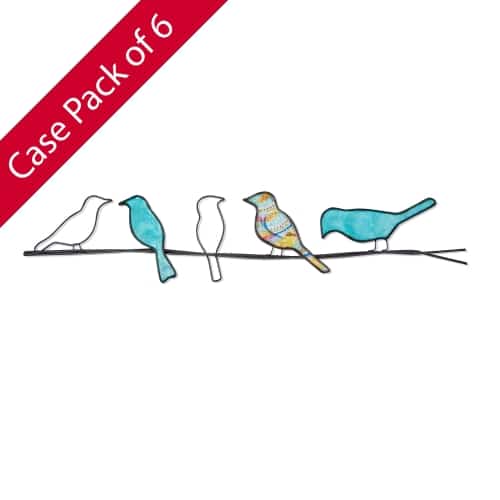 Case of 6 An old parable states that five birds were resting on a wire. Two decided to fly south. How many were birds are left? One's initial answer may be three, however, the answer is still five. The moral of the fable is actions are more important than intention; a kind reminder that a truer picture of one's character is drawn by actions. The artisan captures this parable by lining up five birds socializing on a wire. The basic frame of this piece is created using tin, which is powder coated with a black finish. The frame is reinforced using tin wire along the inner edge. The front of the body is adorned with capiz. Capiz is an oyster shell and the primary purpose of the oyster is as a source of food. However, the by-product, the shell, can be used for decoration. Due to it being a natural material, the natural colors of the capiz may come through as tans and browns underneath the hand-painted surface.
Case of 6 An old parable states that five birds were resting on a wire. Two decided to fly south. How many were birds are left? One's initial answer may be three, however, the answer is still five. The moral of the fable is actions are more important than intention; a kind reminder that a truer picture of one's character is drawn by actions. The artisan captures this parable by lining up five birds socializing on a wire. The basic frame of this piece is created using tin, which is powder coated with a black finish. The frame is reinforced using tin wire along the inner edge. The front of the body is adorned with capiz. Capiz is an oyster shell and the primary purpose of the oyster is as a source of food. However, the by-product, the shell, can be used for decoration. Due to it being a natural material, the natural colors of the capiz may come through as tans and browns underneath the hand-painted surface. -

 An old parable states that five birds were resting on a wire. Two decided to fly south. How many were birds are left? One's initial answer may be three, however, the answer is still five. The moral of the fable is actions are more important than intention; a kind reminder that a truer picture of one's character is drawn by actions. The artisan captures this parable by lining up five birds socializing on a wire. The basic frame of this piece is created using tin, which is powder coated with a black finish. The frame is reinforced using tin wire along the inner edge. The front of the body is adorned with capiz. Capiz is an oyster shell and the primary purpose of the oyster is as a source of food. However, the by-product, the shell, can be used for decoration. Due to it being a natural material, the natural colors of the capiz may come through as tans and browns underneath the hand-painted surface.
An old parable states that five birds were resting on a wire. Two decided to fly south. How many were birds are left? One's initial answer may be three, however, the answer is still five. The moral of the fable is actions are more important than intention; a kind reminder that a truer picture of one's character is drawn by actions. The artisan captures this parable by lining up five birds socializing on a wire. The basic frame of this piece is created using tin, which is powder coated with a black finish. The frame is reinforced using tin wire along the inner edge. The front of the body is adorned with capiz. Capiz is an oyster shell and the primary purpose of the oyster is as a source of food. However, the by-product, the shell, can be used for decoration. Due to it being a natural material, the natural colors of the capiz may come through as tans and browns underneath the hand-painted surface. -

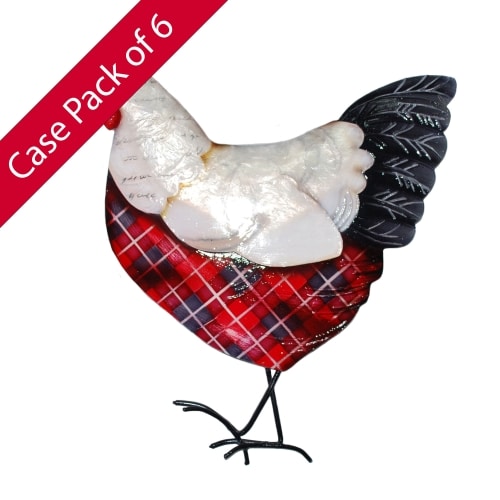 Case of 6 Farm animals are a common theme in the modern farmhouse design with plaid often used as an accent. Featuring modern farmhouse themes, this chicken is both classic and fun in the way the basic colors are portrayed on the familiar design shape. The mother of pearl oyster shell gives the piece an aged patina Modern farmhouse themes also about bringing the old back to new. As an added detail, the neck of the chicken features an excerpt of an old handwritten letter. The basic frame of this piece is created using tin, which is powder coated with a black finish. The frame is reinforced using tin wire along the inner edge. The front of the body is adorned with capiz. Capiz is an oyster shell and the primary purpose of the oyster is as a source of food. However, the by-product, the shell, can be used for decoration. Due to it being a natural material, the natural colors of the capiz may come through as tans and browns underneath the hand-painted surface.
Case of 6 Farm animals are a common theme in the modern farmhouse design with plaid often used as an accent. Featuring modern farmhouse themes, this chicken is both classic and fun in the way the basic colors are portrayed on the familiar design shape. The mother of pearl oyster shell gives the piece an aged patina Modern farmhouse themes also about bringing the old back to new. As an added detail, the neck of the chicken features an excerpt of an old handwritten letter. The basic frame of this piece is created using tin, which is powder coated with a black finish. The frame is reinforced using tin wire along the inner edge. The front of the body is adorned with capiz. Capiz is an oyster shell and the primary purpose of the oyster is as a source of food. However, the by-product, the shell, can be used for decoration. Due to it being a natural material, the natural colors of the capiz may come through as tans and browns underneath the hand-painted surface. -
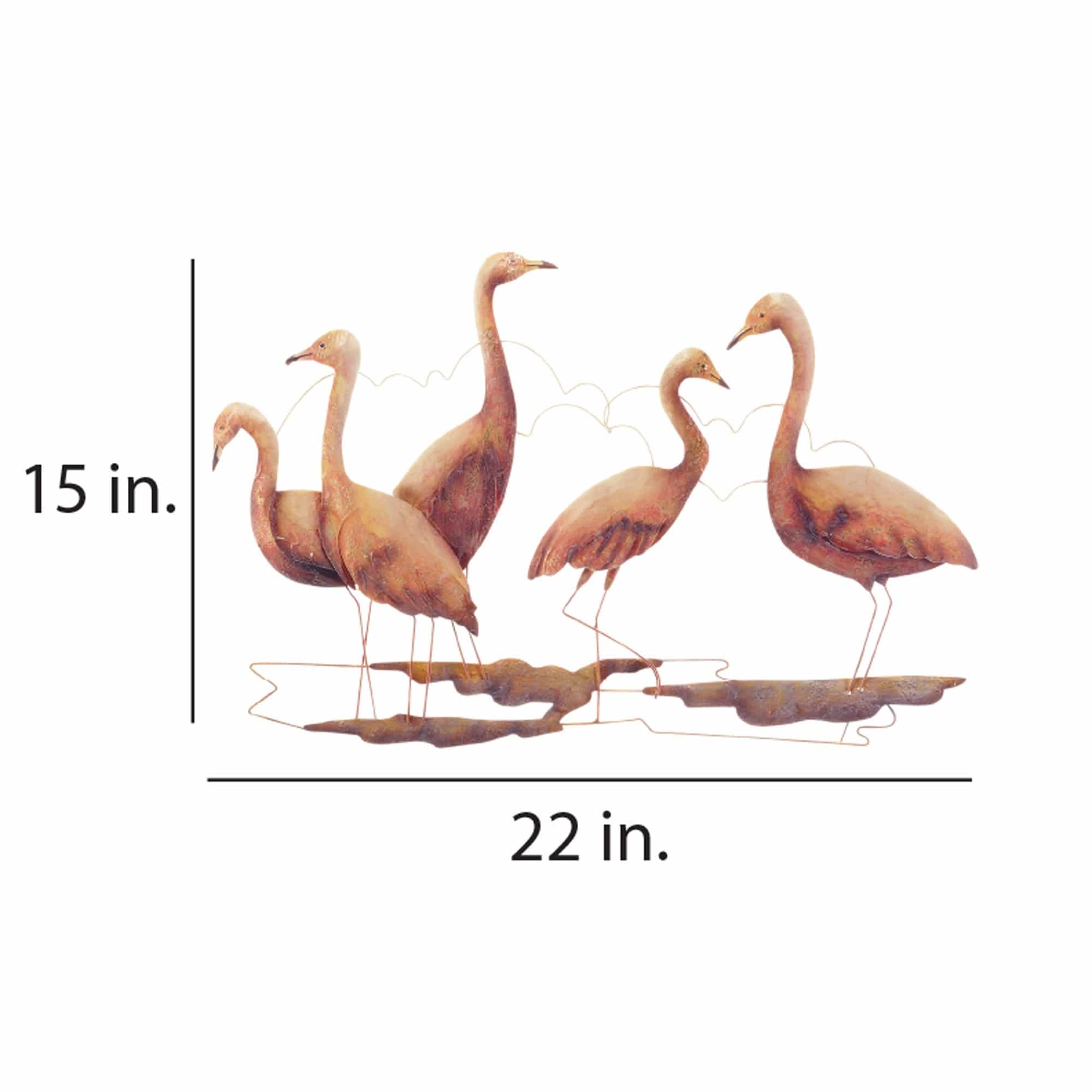
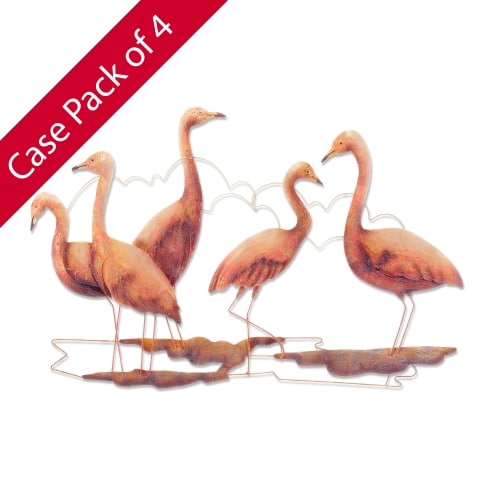 Case of 4 The name 'flamingo' comes from the Portuguese or Spanish 'flamengo,' which means 'flame-colored.' Born gray in hues, flamingos get their flamboyant color from brine shrimp that make up most of their diet. Flamingos are very social animals and the artist depicts this by creating a group of five birds wading through the calm water enjoying a warm day. The artist takes time in pressing the metal creating texture in the wings and body, and also uses metallic paints to highlight the famous colors of one of the most recognizable birds on the planet. The basic frame of this piece is created using tin, which is powder coated with a black finish. The frame is reinforced using tin wire along the inner edge. The front of the body is adorned with capiz. Capiz is an oyster shell and the primary purpose of the oyster is as a source of food. However, the by-product, the shell, can be used for decoration. Due to it being a natural material, the natural colors of the capiz may come through as tans and browns underneath the hand-painted surface.
Case of 4 The name 'flamingo' comes from the Portuguese or Spanish 'flamengo,' which means 'flame-colored.' Born gray in hues, flamingos get their flamboyant color from brine shrimp that make up most of their diet. Flamingos are very social animals and the artist depicts this by creating a group of five birds wading through the calm water enjoying a warm day. The artist takes time in pressing the metal creating texture in the wings and body, and also uses metallic paints to highlight the famous colors of one of the most recognizable birds on the planet. The basic frame of this piece is created using tin, which is powder coated with a black finish. The frame is reinforced using tin wire along the inner edge. The front of the body is adorned with capiz. Capiz is an oyster shell and the primary purpose of the oyster is as a source of food. However, the by-product, the shell, can be used for decoration. Due to it being a natural material, the natural colors of the capiz may come through as tans and browns underneath the hand-painted surface. -

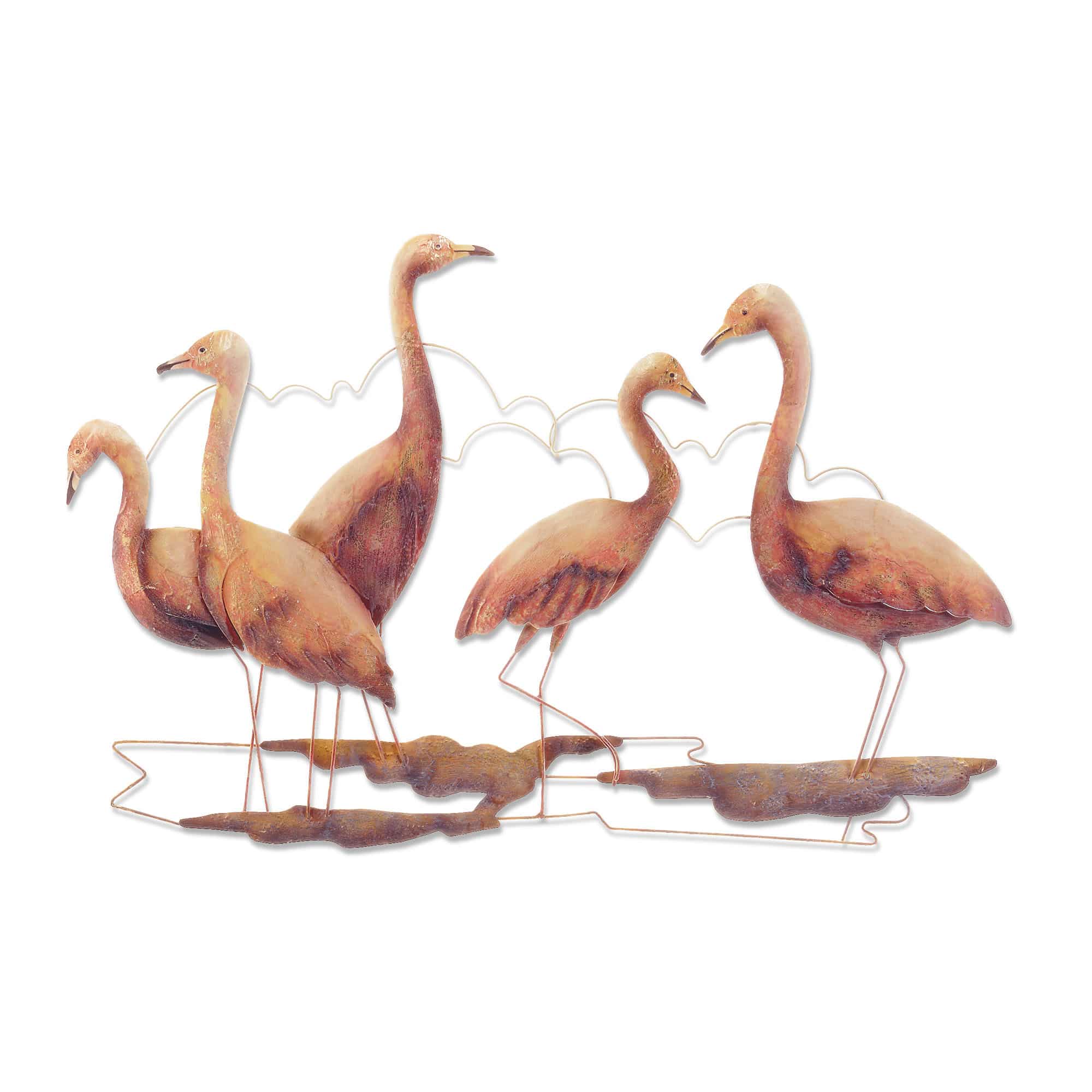 The name 'flamingo' comes from the Portuguese or Spanish 'flamengo,' which means 'flame-colored.' Born gray in hues, flamingos get their flamboyant color from brine shrimp that make up most of their diet. Flamingos are very social animals and the artist depicts this by creating a group of five birds wading through the calm water enjoying a warm day. The artist takes time in pressing the metal creating texture in the wings and body, and also uses metallic paints to highlight the famous colors of one of the most recognizable birds on the planet. The basic frame of this piece is created using tin, which is powder coated with a black finish. The frame is reinforced using tin wire along the inner edge. The front of the body is adorned with capiz. Capiz is an oyster shell and the primary purpose of the oyster is as a source of food. However, the by-product, the shell, can be used for decoration. Due to it being a natural material, the natural colors of the capiz may come through as tans and browns underneath the hand-painted surface.
The name 'flamingo' comes from the Portuguese or Spanish 'flamengo,' which means 'flame-colored.' Born gray in hues, flamingos get their flamboyant color from brine shrimp that make up most of their diet. Flamingos are very social animals and the artist depicts this by creating a group of five birds wading through the calm water enjoying a warm day. The artist takes time in pressing the metal creating texture in the wings and body, and also uses metallic paints to highlight the famous colors of one of the most recognizable birds on the planet. The basic frame of this piece is created using tin, which is powder coated with a black finish. The frame is reinforced using tin wire along the inner edge. The front of the body is adorned with capiz. Capiz is an oyster shell and the primary purpose of the oyster is as a source of food. However, the by-product, the shell, can be used for decoration. Due to it being a natural material, the natural colors of the capiz may come through as tans and browns underneath the hand-painted surface. -

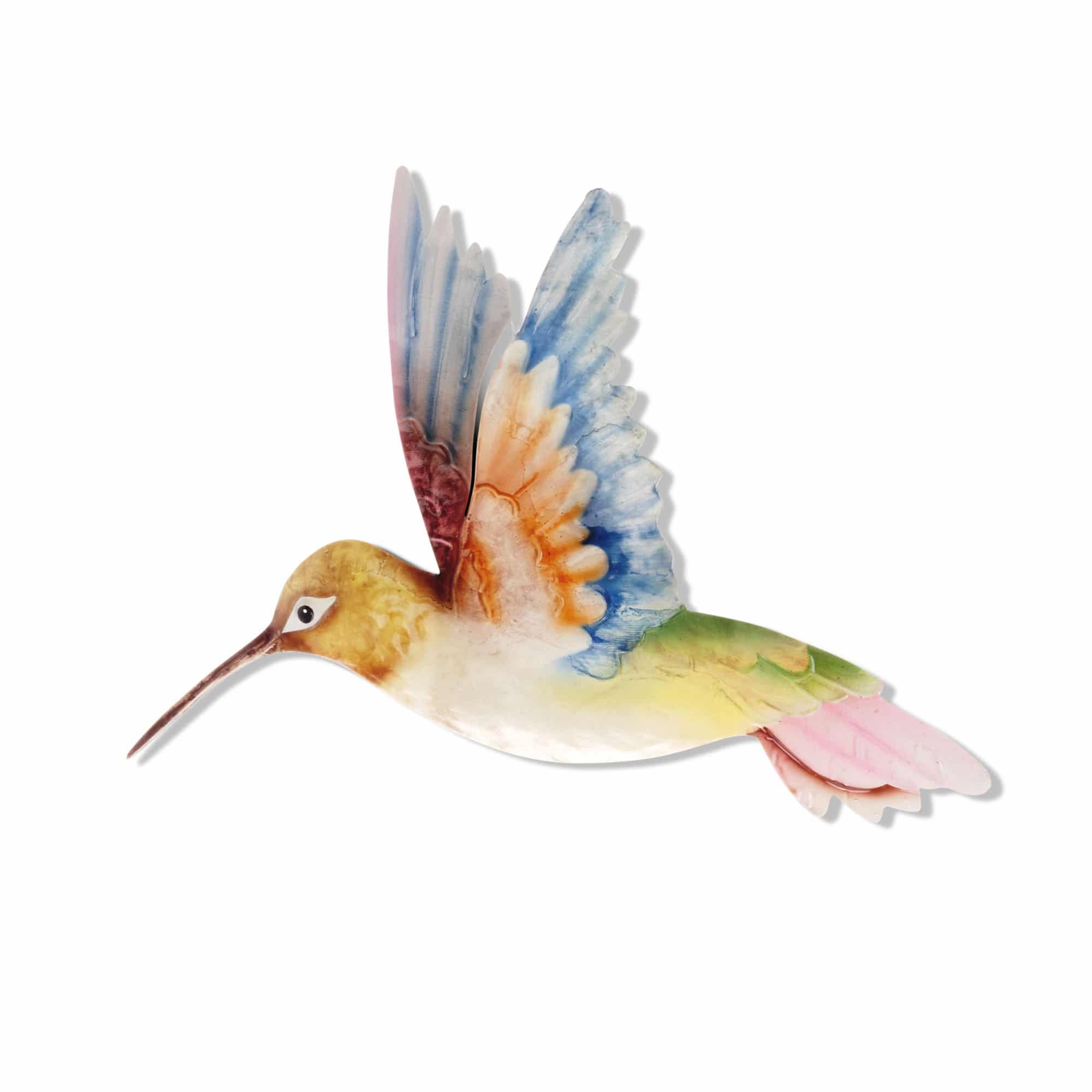
This hummingbird is inspired by many different species. The artist captures the colors and grace of a hummingbird in mid-flight. Its chest is adorned with capiz shell, which is then hand-painted to the magnificent colors seen in many species. This hummingbird brings a sense of purpose as it flies from flower to flower.
The basic frame of the hummingbird is created using tin, which is powder coated with a black finish. The frame is reinforced using tin wire along the inner edge. Capiz is an oyster shell and the primary purpose of the oyster is as a source of food. However, the by-product, the shell, can be used for decoration. Due to it being a natural material, the natural colors of the capiz come through as tans and browns underneath the paint. The shell is then painted the bold colors you see. The entire front facing piece is carefully hand-painted keeping in mind the reflective qualities in the color of hummingbirds.
-
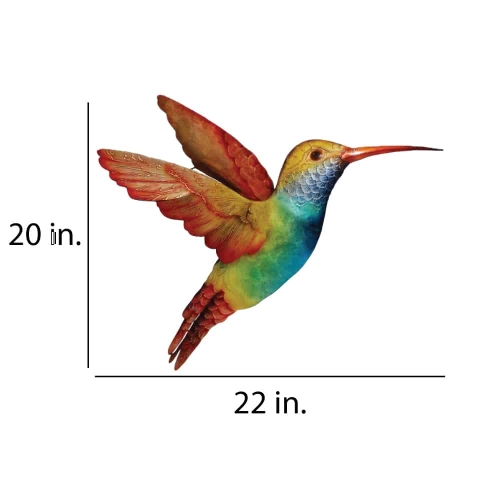
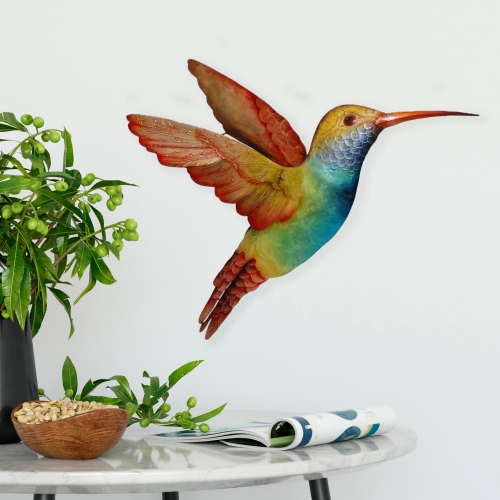 This hummingbird is inspired by many different species. The artist captures the colors and grace of a hummingbird in mid-flight. Its chest is adorned with capiz shell, which is then hand-painted to the magnificent colors seen in many species. This hummingbird brings a sense of purpose as it flies from flower to flower. The basic frame of the hummingbird is created using tin, which is powder coated with a black finish. The frame is reinforced using tin wire along the inner edge. Capiz is an oyster shell and the primary purpose of the oyster is as a source of food. However, the by-product, the shell, can be used for decoration. Due to it being a natural material, the natural colors of the capiz come through as tans and browns underneath the paint. The shell is then painted the bold colors you see. The entire front facing piece is carefully hand-painted keeping in mind the reflective qualities in the color of hummingbirds.
This hummingbird is inspired by many different species. The artist captures the colors and grace of a hummingbird in mid-flight. Its chest is adorned with capiz shell, which is then hand-painted to the magnificent colors seen in many species. This hummingbird brings a sense of purpose as it flies from flower to flower. The basic frame of the hummingbird is created using tin, which is powder coated with a black finish. The frame is reinforced using tin wire along the inner edge. Capiz is an oyster shell and the primary purpose of the oyster is as a source of food. However, the by-product, the shell, can be used for decoration. Due to it being a natural material, the natural colors of the capiz come through as tans and browns underneath the paint. The shell is then painted the bold colors you see. The entire front facing piece is carefully hand-painted keeping in mind the reflective qualities in the color of hummingbirds. -
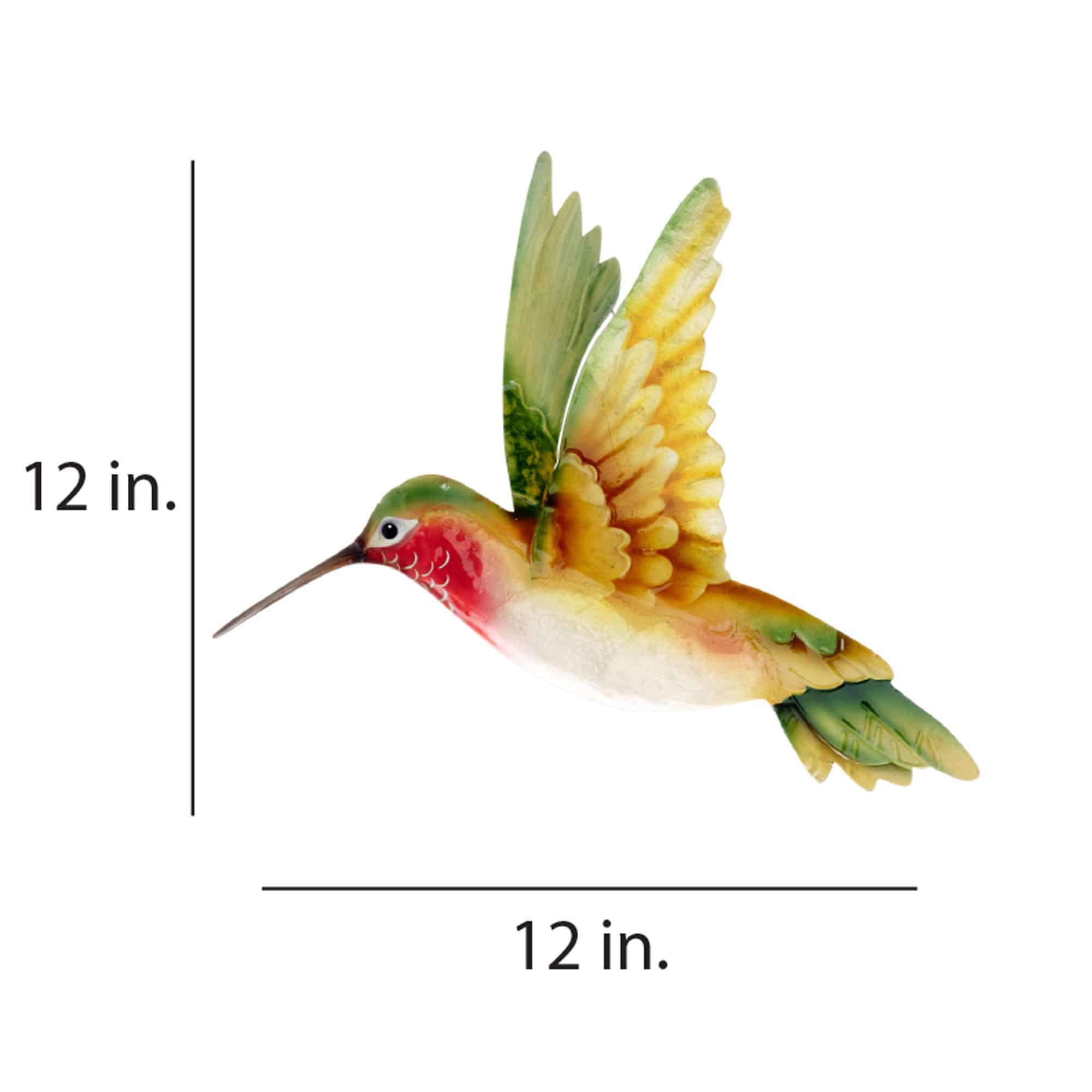
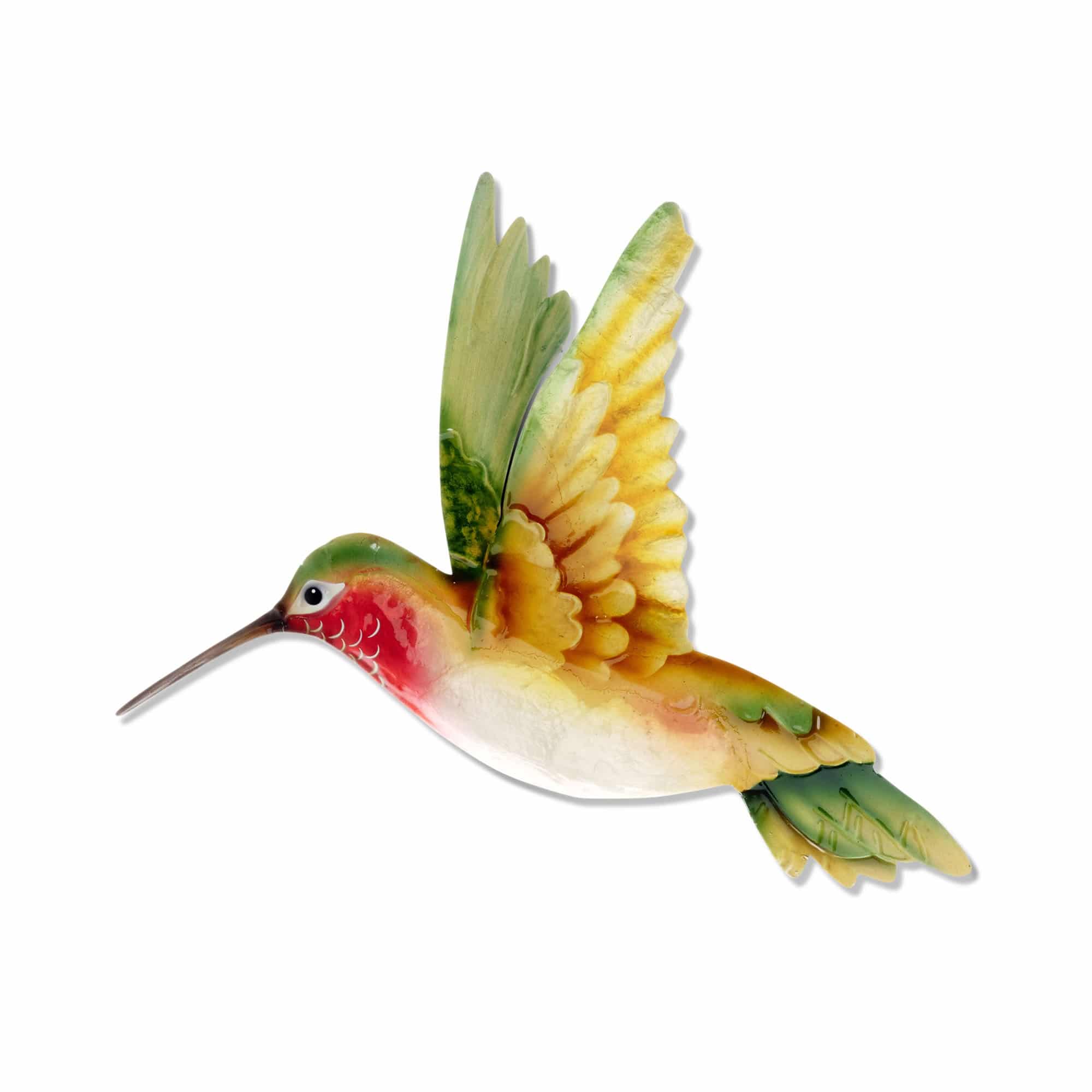
This hummingbird is inspired by the Ruby-throated hummingbird, commonly seen in Eastern North America in the summer. Small yet agile, this hummingbird flies all the way to the southern parts of Central America for the winter. The artist captures the hummingbird in mid-flight. Its chest is adorned with capiz shell, which is then hand-painted to the magnificent colors seen in this species. Bring the spirt of summer into your home by adding this piece of art to your wall.
The basic frame of the hummingbird is created using tin, which is powder coated with a black finish. The frame is reinforced using tin wire along the inner edge. Capiz is an oyster shell and the primary purpose of the oyster is as a source of food. However, the by-product, the shell, can be used for decoration. Due to it being a natural material, the natural colors of the capiz come through as tans and browns underneath the paint. The shell is then painted the bold colors you see. The entire front facing piece is carefully hand-painted keeping in mind the reflective qualities in the color of hummingbirds.
-
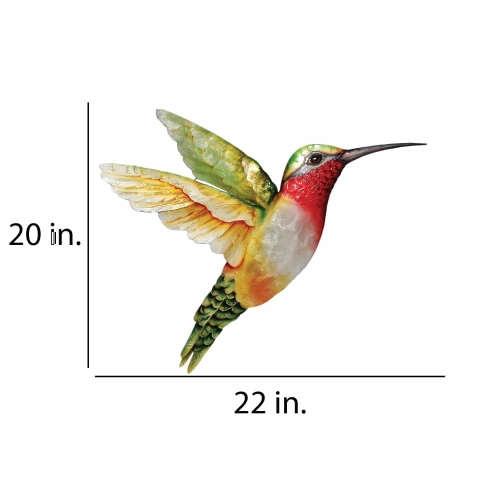
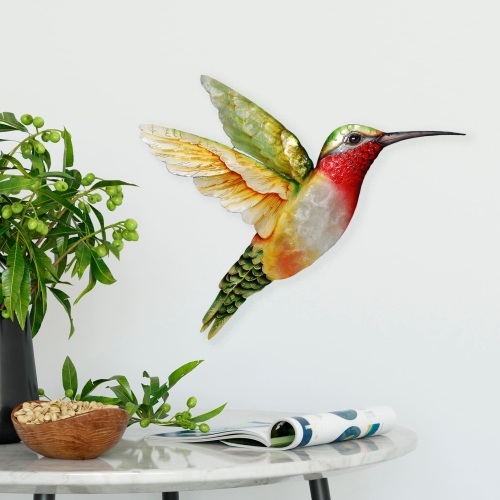 This hummingbird is inspired by many different species. The artist captures the colors and grace of a hummingbird in mid-flight. Its chest is adorned with capiz shell, which is then hand-painted to the magnificent colors seen in many species. This hummingbird brings a sense of purpose as it flies from flower to flower. The basic frame of the hummingbird is created using tin, which is powder coated with a black finish. The frame is reinforced using tin wire along the inner edge. Capiz is an oyster shell and the primary purpose of the oyster is as a source of food. However, the by-product, the shell, can be used for decoration. Due to it being a natural material, the natural colors of the capiz come through as tans and browns underneath the paint. The shell is then painted the bold colors you see. The entire front facing piece is carefully hand-painted keeping in mind the reflective qualities in the color of hummingbirds.
This hummingbird is inspired by many different species. The artist captures the colors and grace of a hummingbird in mid-flight. Its chest is adorned with capiz shell, which is then hand-painted to the magnificent colors seen in many species. This hummingbird brings a sense of purpose as it flies from flower to flower. The basic frame of the hummingbird is created using tin, which is powder coated with a black finish. The frame is reinforced using tin wire along the inner edge. Capiz is an oyster shell and the primary purpose of the oyster is as a source of food. However, the by-product, the shell, can be used for decoration. Due to it being a natural material, the natural colors of the capiz come through as tans and browns underneath the paint. The shell is then painted the bold colors you see. The entire front facing piece is carefully hand-painted keeping in mind the reflective qualities in the color of hummingbirds. -
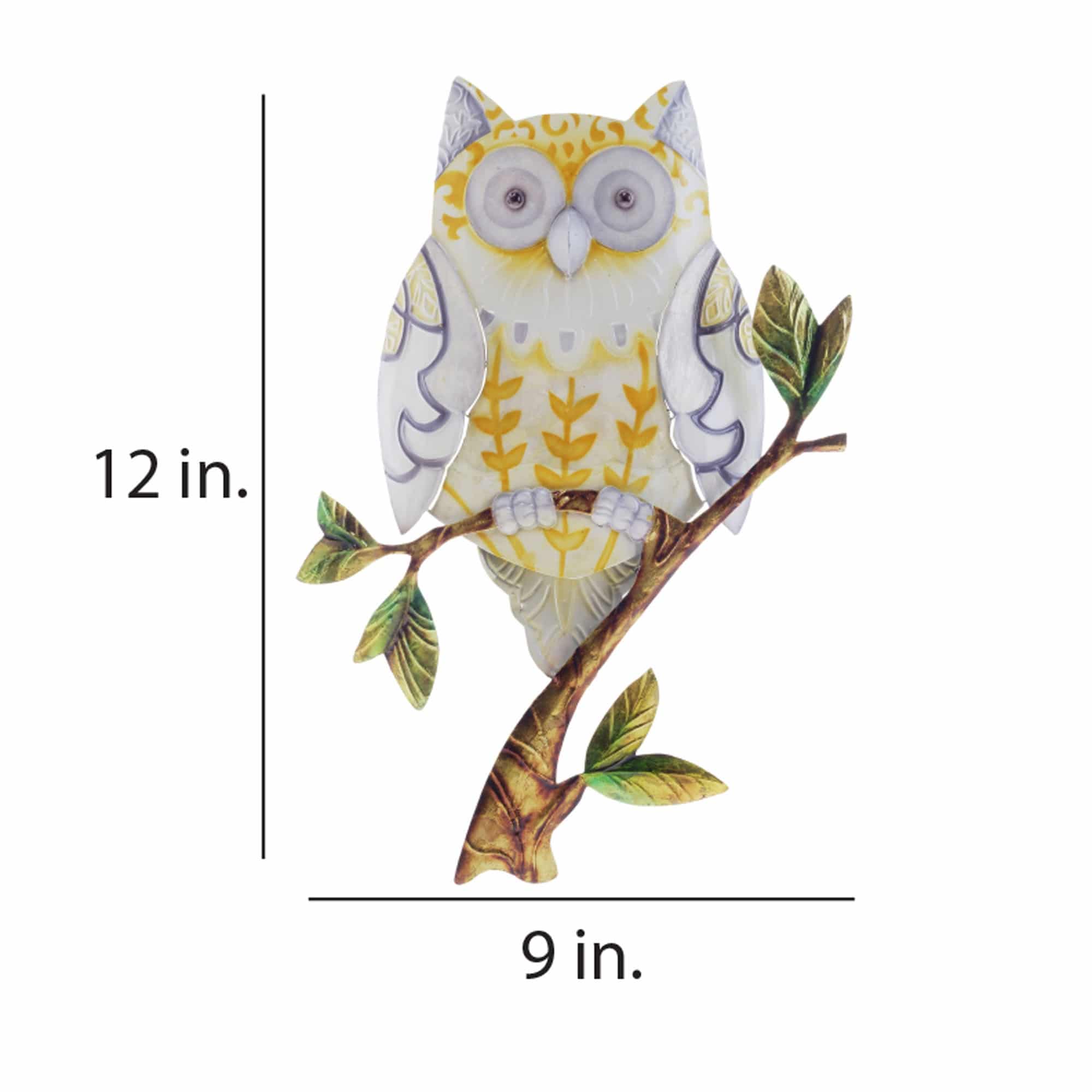
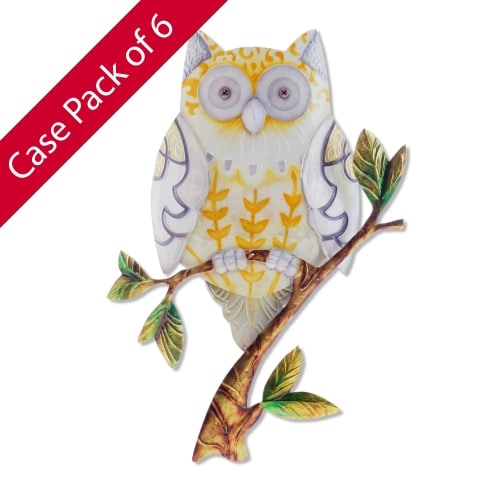 Case of 6 The owl was a bird of prophecy and wisdom in many ancient cultures. Its wide eyes seem to miss nothing and when an owl moves it seems calculated. Even though the colors and designs on the owl are human interpretations, the perched look is defiantly natural. The artist uses capiz shell on the wings to highlight the reflective nature of some of the owl's feathers. The basic frame of the owl is created using tin, which is powder coated with a black finish. The frame is reinforced using tin wire along the inner edge. Capiz is an oyster shell and the primary purpose of the oyster is as a source of food. However, the by-product, the shell, can be used for decoration.
Case of 6 The owl was a bird of prophecy and wisdom in many ancient cultures. Its wide eyes seem to miss nothing and when an owl moves it seems calculated. Even though the colors and designs on the owl are human interpretations, the perched look is defiantly natural. The artist uses capiz shell on the wings to highlight the reflective nature of some of the owl's feathers. The basic frame of the owl is created using tin, which is powder coated with a black finish. The frame is reinforced using tin wire along the inner edge. Capiz is an oyster shell and the primary purpose of the oyster is as a source of food. However, the by-product, the shell, can be used for decoration. -
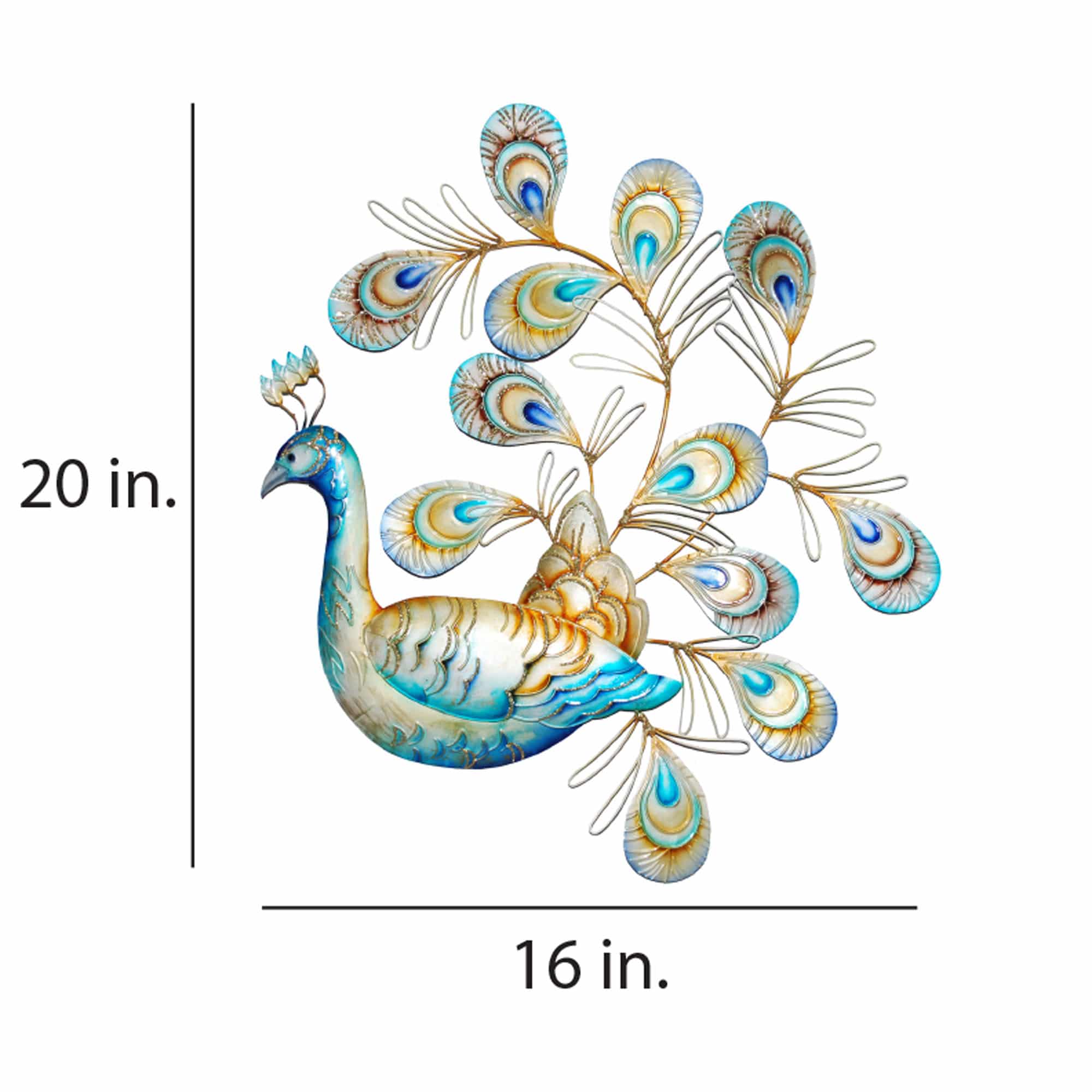
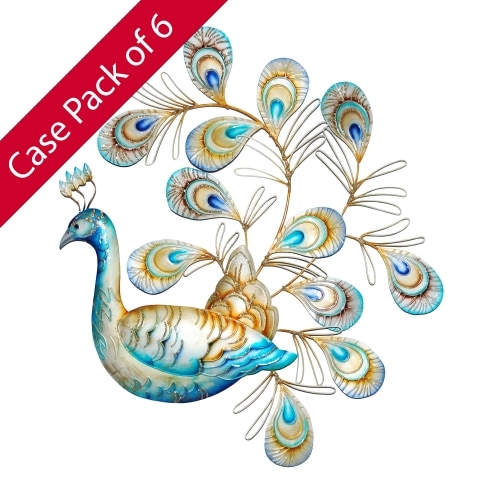 Case of 4 Tailfeathers raised, this Indian peacock is strutting his stuff. On display is its iridescent blue and green, metallic-colored, plumage. Throughout its tailfeathers, the artists drew in the peacock's distinctive eyespots, with the eye itself in different colors. The chest of the bird is crafted from capiz shell, carefully painted in the blues and greens this bird is known for. It fits perfectly within any decor style and will add the finishing touch to its surroundings. The basic frame of this piece is created using tin, which is powder coated with a black finish. The frame is reinforced using tin wire along the inner edge. The front of the body is adorned with capiz. Capiz is an oyster shell and the primary purpose of the oyster is as a source of food. However, the by-product, the shell, can be used for decoration. Due to it being a natural material, the natural colors of the capiz may come through as tans and browns underneath the hand-painted surface.
Case of 4 Tailfeathers raised, this Indian peacock is strutting his stuff. On display is its iridescent blue and green, metallic-colored, plumage. Throughout its tailfeathers, the artists drew in the peacock's distinctive eyespots, with the eye itself in different colors. The chest of the bird is crafted from capiz shell, carefully painted in the blues and greens this bird is known for. It fits perfectly within any decor style and will add the finishing touch to its surroundings. The basic frame of this piece is created using tin, which is powder coated with a black finish. The frame is reinforced using tin wire along the inner edge. The front of the body is adorned with capiz. Capiz is an oyster shell and the primary purpose of the oyster is as a source of food. However, the by-product, the shell, can be used for decoration. Due to it being a natural material, the natural colors of the capiz may come through as tans and browns underneath the hand-painted surface. -

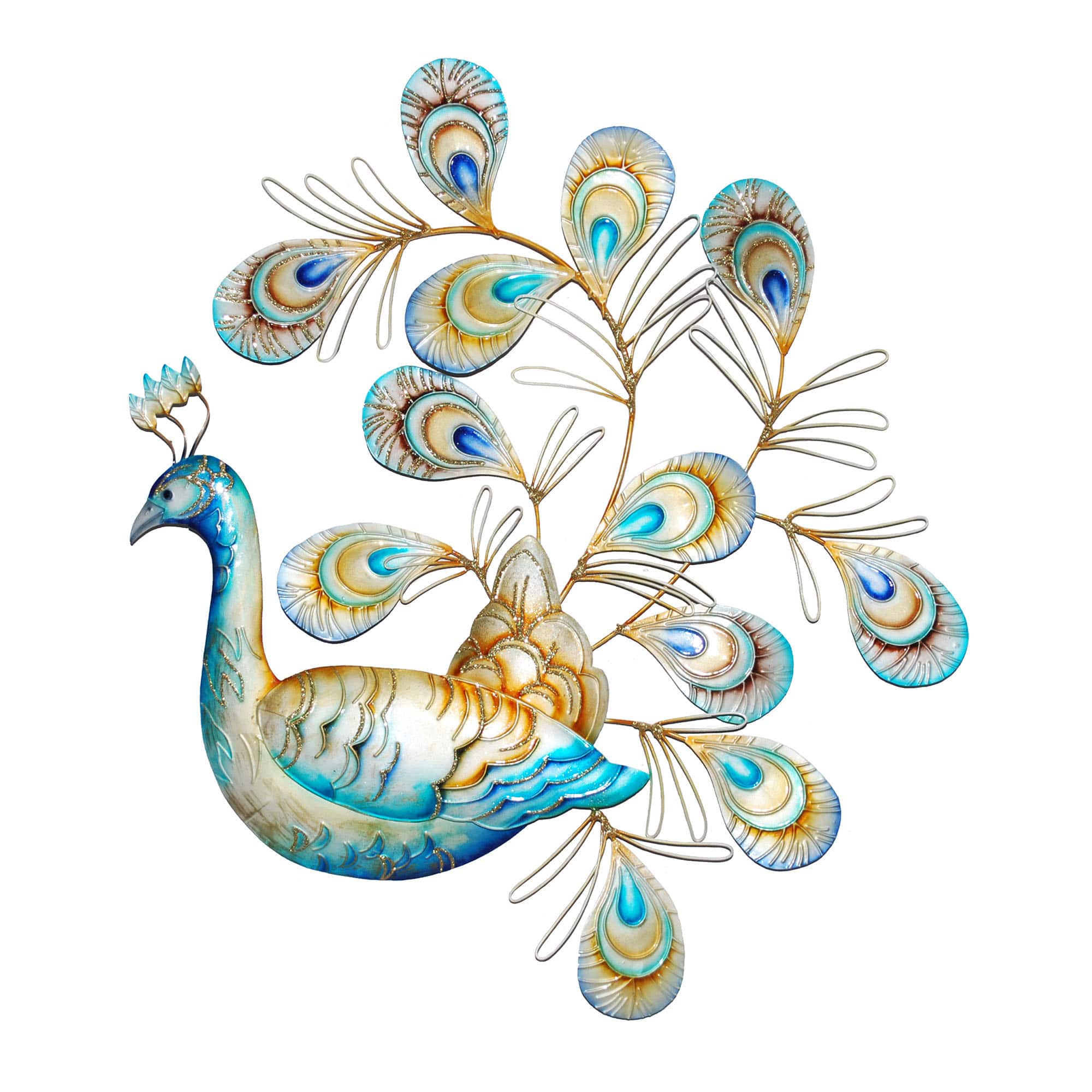 Tailfeathers raised, this Indian peacock is strutting his stuff. On display is its iridescent blue and green, metallic-colored, plumage. Throughout its tailfeathers, the artists drew in the peacock's distinctive eyespots, with the eye itself in different colors. The chest of the bird is crafted from capiz shell, carefully painted in the blues and greens this bird is known for. It fits perfectly within any decor style and will add the finishing touch to its surroundings. The basic frame of this piece is created using tin, which is powder coated with a black finish. The frame is reinforced using tin wire along the inner edge. The front of the body is adorned with capiz. Capiz is an oyster shell and the primary purpose of the oyster is as a source of food. However, the by-product, the shell, can be used for decoration. Due to it being a natural material, the natural colors of the capiz may come through as tans and browns underneath the hand-painted surface.
Tailfeathers raised, this Indian peacock is strutting his stuff. On display is its iridescent blue and green, metallic-colored, plumage. Throughout its tailfeathers, the artists drew in the peacock's distinctive eyespots, with the eye itself in different colors. The chest of the bird is crafted from capiz shell, carefully painted in the blues and greens this bird is known for. It fits perfectly within any decor style and will add the finishing touch to its surroundings. The basic frame of this piece is created using tin, which is powder coated with a black finish. The frame is reinforced using tin wire along the inner edge. The front of the body is adorned with capiz. Capiz is an oyster shell and the primary purpose of the oyster is as a source of food. However, the by-product, the shell, can be used for decoration. Due to it being a natural material, the natural colors of the capiz may come through as tans and browns underneath the hand-painted surface. -
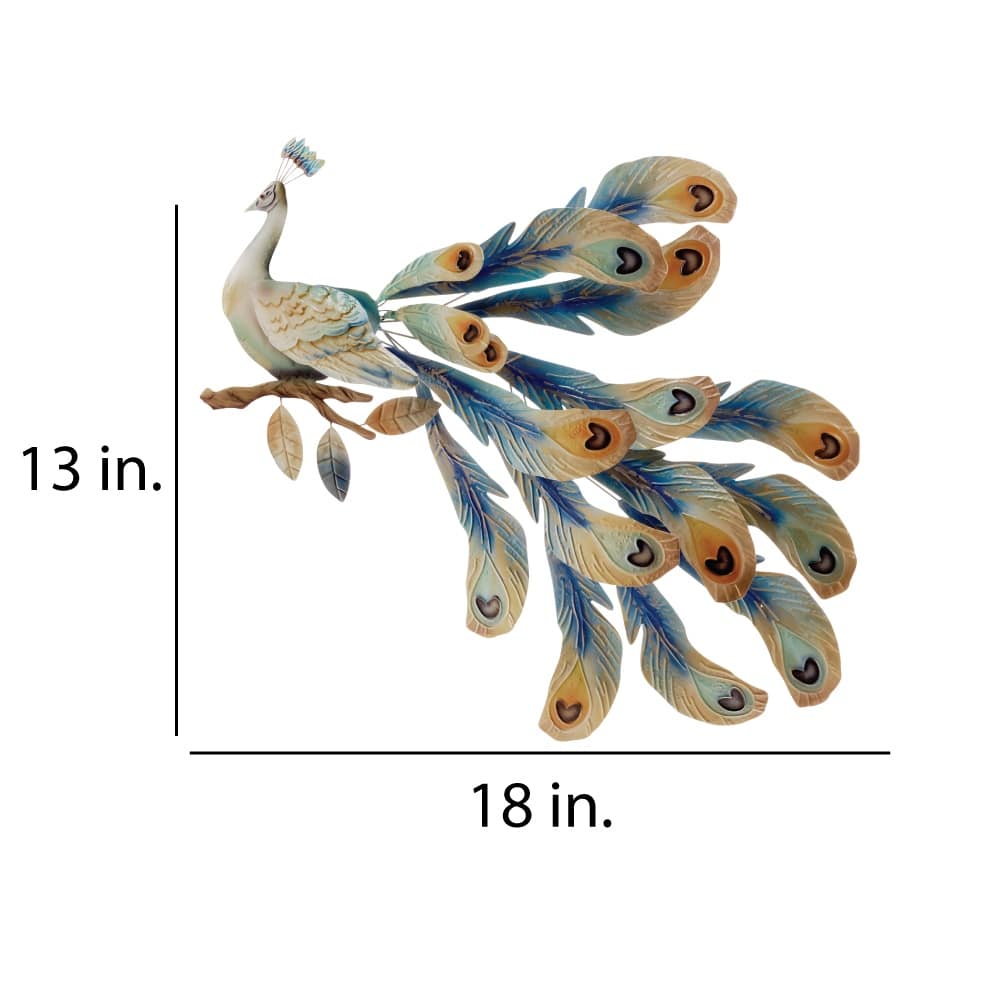
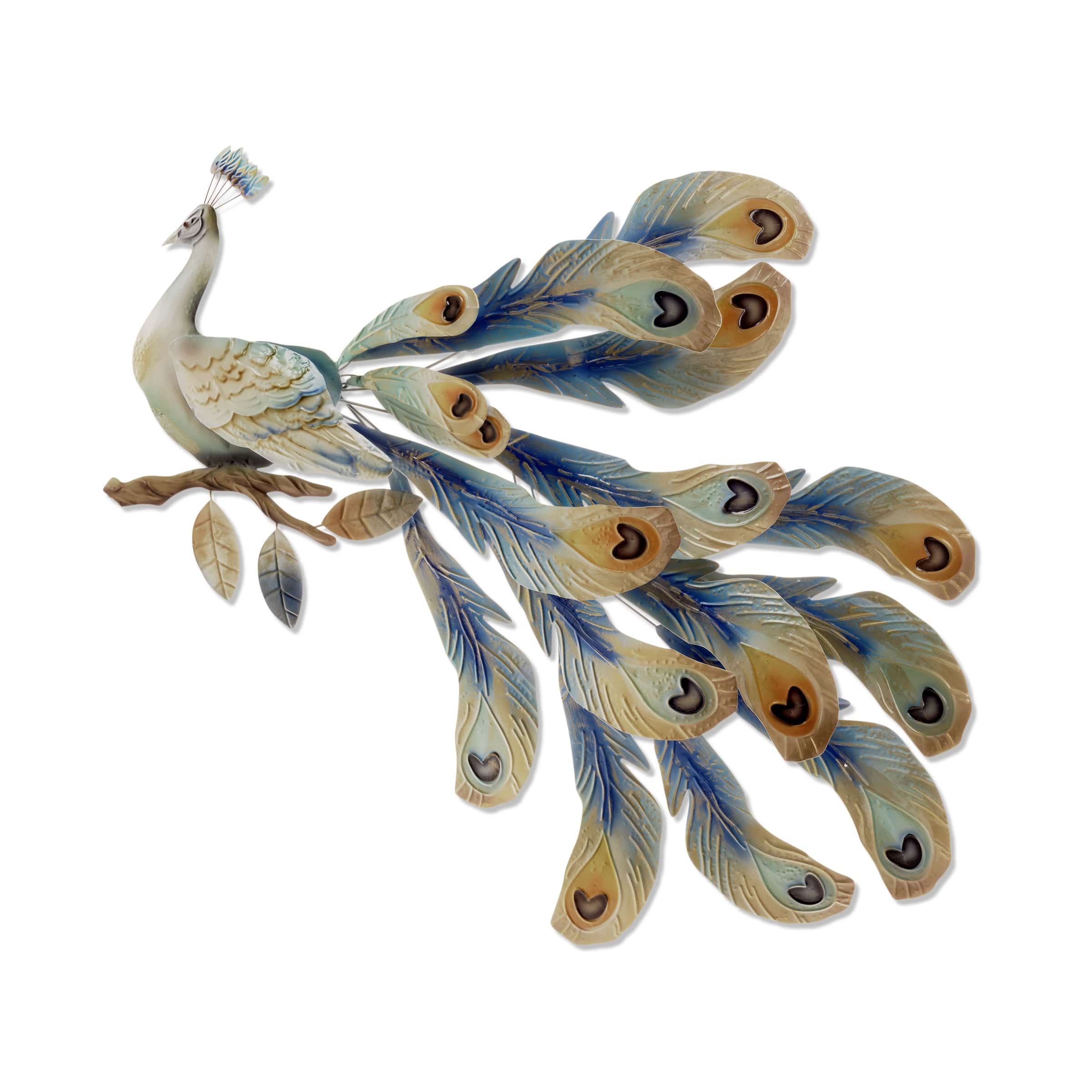 This elegant peacock is relaxed and calm, pluming through its feathers. Throughout its tail-feathers, the artists drew in the peacock's distinctive eyespots, with the eye itself in different colors. The chest of the bird is crafted from capiz shell, carefully painted in the blues and greens this bird is known for. It will fit perfectly within any decor style and add the finishing touch to its surroundings. The basic frame of the cat is created using tin, which is powder coated with a black finish. The frame is reinforced using tin wire along the inner edge. Capiz is an oyster shell and the primary purpose of the oyster is as a source of food. However, the by-product, the shell, can be used for decoration. Due to it being a natural material, the natural colors of the capiz come through as tans and browns underneath the paint. The shell is then painted the bold colors you see. The entire front facing piece is carefully hand-painted.
This elegant peacock is relaxed and calm, pluming through its feathers. Throughout its tail-feathers, the artists drew in the peacock's distinctive eyespots, with the eye itself in different colors. The chest of the bird is crafted from capiz shell, carefully painted in the blues and greens this bird is known for. It will fit perfectly within any decor style and add the finishing touch to its surroundings. The basic frame of the cat is created using tin, which is powder coated with a black finish. The frame is reinforced using tin wire along the inner edge. Capiz is an oyster shell and the primary purpose of the oyster is as a source of food. However, the by-product, the shell, can be used for decoration. Due to it being a natural material, the natural colors of the capiz come through as tans and browns underneath the paint. The shell is then painted the bold colors you see. The entire front facing piece is carefully hand-painted. -

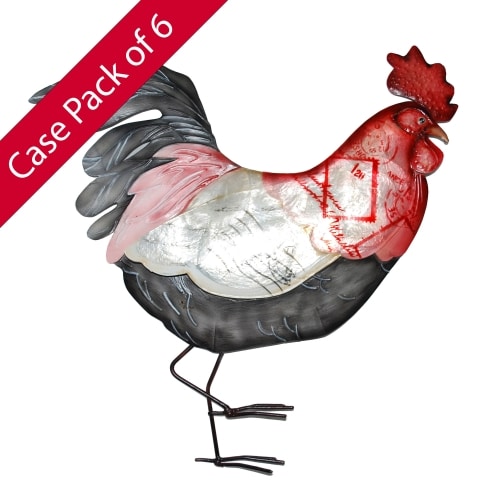 Case of 6 This vintage designed rooster is influenced by the designs of the early 20th century. The artist took great care in making sure the rooster's comb and wattle appear authentic by pressing texture into the metal frame. Furthermore, the artist made sure to use realistic colors and shading. Even the body and the tail feathers were pressed and cut to mimic the body of a real rooster. However, the center of the rooster deviates from the realism and merges into the nostalgic with what appears to be an envelope of an old handwritten letter. The capiz oyster shell gives an aged patina making the rooster and the letter feel like it has been around for a very long time. The letter is an artistic way of tying in a piece of the old into the new. The basic frame of this piece is created using tin, which is powder coated with a black finish. The frame is reinforced using tin wire along the inner edge. The front of the body is adorned with capiz. Capiz is an oyster shell and the primary purpose of the oyster is as a source of food. However, the by-product, the shell, can be used for decoration. Due to it being a natural material, the natural colors of the capiz may come through as tans and browns underneath the hand-painted surface.
Case of 6 This vintage designed rooster is influenced by the designs of the early 20th century. The artist took great care in making sure the rooster's comb and wattle appear authentic by pressing texture into the metal frame. Furthermore, the artist made sure to use realistic colors and shading. Even the body and the tail feathers were pressed and cut to mimic the body of a real rooster. However, the center of the rooster deviates from the realism and merges into the nostalgic with what appears to be an envelope of an old handwritten letter. The capiz oyster shell gives an aged patina making the rooster and the letter feel like it has been around for a very long time. The letter is an artistic way of tying in a piece of the old into the new. The basic frame of this piece is created using tin, which is powder coated with a black finish. The frame is reinforced using tin wire along the inner edge. The front of the body is adorned with capiz. Capiz is an oyster shell and the primary purpose of the oyster is as a source of food. However, the by-product, the shell, can be used for decoration. Due to it being a natural material, the natural colors of the capiz may come through as tans and browns underneath the hand-painted surface. -

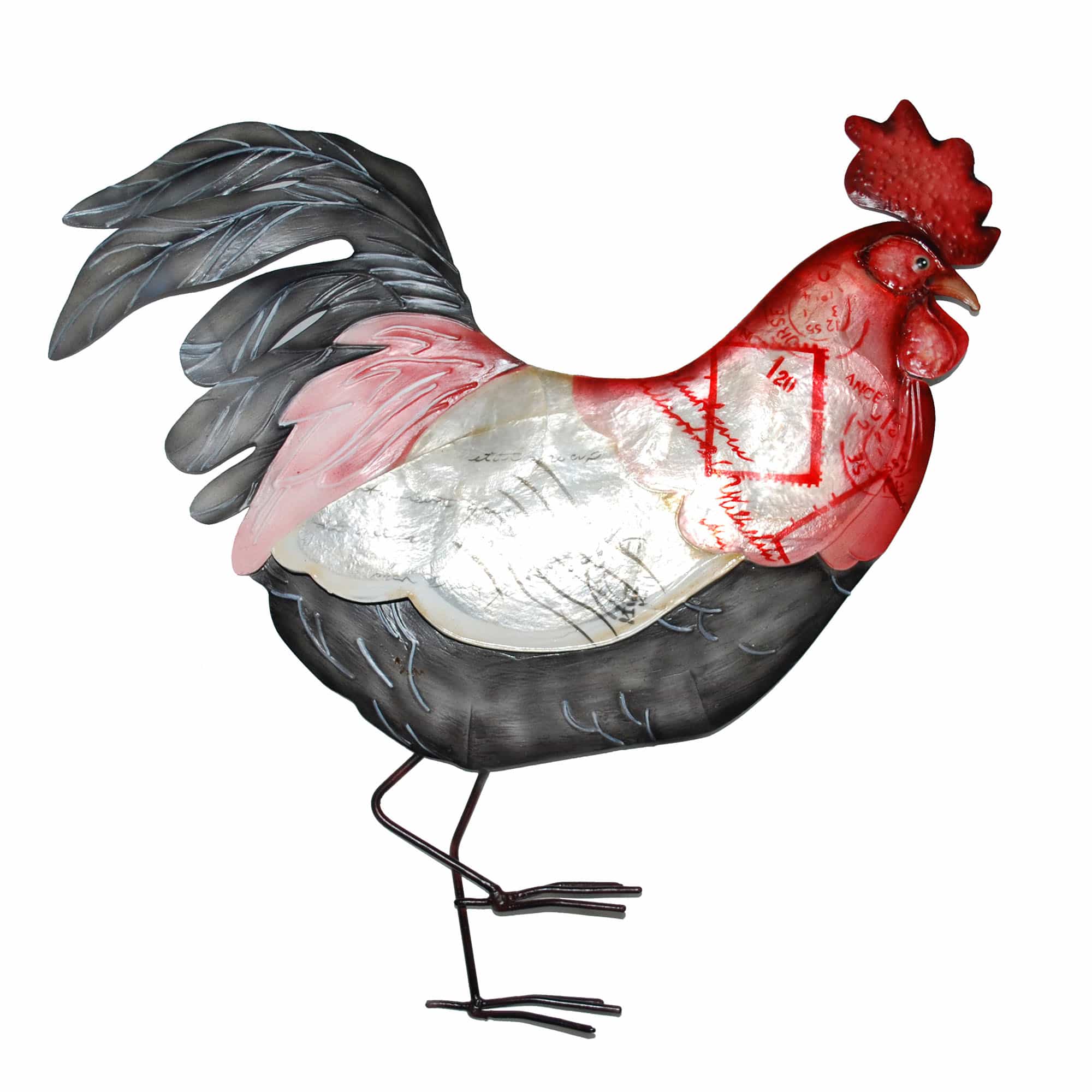 This vintage designed rooster is influenced by the designs of the early 20th century. The artist took great care in making sure the rooster's comb and wattle appear authentic by pressing texture into the metal frame. Furthermore, the artist made sure to use realistic colors and shading. Even the body and the tail feathers were pressed and cut to mimic the body of a real rooster. However, the center of the rooster deviates from the realism and merges into the nostalgic with what appears to be an envelope of an old handwritten letter. The capiz oyster shell gives an aged patina making the rooster and the letter feel like it has been around for a very long time. The letter is an artistic way of tying in a piece of the old into the new. The basic frame of this piece is created using tin, which is powder coated with a black finish. The frame is reinforced using tin wire along the inner edge. The front of the body is adorned with capiz. Capiz is an oyster shell and the primary purpose of the oyster is as a source of food. However, the by-product, the shell, can be used for decoration. Due to it being a natural material, the natural colors of the capiz may come through as tans and browns underneath the hand-painted surface.
This vintage designed rooster is influenced by the designs of the early 20th century. The artist took great care in making sure the rooster's comb and wattle appear authentic by pressing texture into the metal frame. Furthermore, the artist made sure to use realistic colors and shading. Even the body and the tail feathers were pressed and cut to mimic the body of a real rooster. However, the center of the rooster deviates from the realism and merges into the nostalgic with what appears to be an envelope of an old handwritten letter. The capiz oyster shell gives an aged patina making the rooster and the letter feel like it has been around for a very long time. The letter is an artistic way of tying in a piece of the old into the new. The basic frame of this piece is created using tin, which is powder coated with a black finish. The frame is reinforced using tin wire along the inner edge. The front of the body is adorned with capiz. Capiz is an oyster shell and the primary purpose of the oyster is as a source of food. However, the by-product, the shell, can be used for decoration. Due to it being a natural material, the natural colors of the capiz may come through as tans and browns underneath the hand-painted surface.



